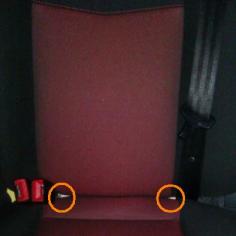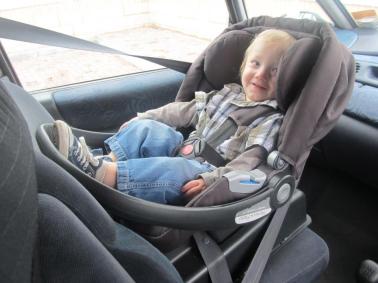What is an infant seat?
An infant seat is the first stage seat you will use for a new baby. All babies, toddlers and children are required by law to travel in a suitable child restraint with very few exceptions.
The infant seat is rear facing and ‘bucket’ like; which cradles the baby (with the exception of lie flat sleepers,) they have either a 3 or 5 point harness to strap them in. You can expect to see a carry handle on the seat which has the dual purpose of allowing you to carry baby into the house without disturbing them, and it also acts as a roll bar should you be involved in a collision.
Why do you have to have one?
As previously mentioned, all babies, toddlers and children are required to use a suitable child restraint by law with few exceptions. This is because they are not small adults and their bodies are still developing, if they used just the adult seat belt and were involved in a collision they would be at much higher risk of very serious and fatal injuries. The seat belt is designed for adult use, not child use; therefore a child restraint is required.
You are not allowed to hold or carry a baby in the car either, if you were involved in a collision you would be unable to protect the baby – they must travel in a rear facing restraint. If the baby needs nursing or comforting, find a safe place to pull over and then attend to the baby.
It is worth knowing that many hospitals will not let you take baby home unless you have a safe and suitable child restraint.
In a nut shell – we have an adult seat belt to keep us as safe as possible; a child needs a child restraint that is designed to do the same.
Why must babies rear face?
The main reason a baby, and even toddler must rear face is due to the size and weight of their head in relation to their neck and spine. If a baby or toddler is involved in an impact when front facing they are thrown into the harness, which restrains them, but their head continues forward putting enormous strain on their neck and spine. This can cause serious and fatal injuries to a child which would be avoided if they were rear facing. When a child is rear facing they are cradled by the seat back, in an impact they are pushed into the back of the child seat and their head, neck and spine remain in line with much reduced forces on the child’s body, as the seat absorbs it all.
It is law for babies and toddlers to rear face until 9kg/20lbs, but they are far safer staying in the infant seat for as long as possible.
*Note: the law is changing in mid 2013 for babies to remain rear facing to 15 months*
What’s the issue with the front seat and the air bag?
It is illegal to have a rear facing child seat fitted to a front seat that has an active air bag. This is because when the airbag is deployed it can come out at up to 200mph, if that hit the back of your child’s car seat the consequences would be devastating. If you want your child to be in the front with you then make sure the air bag is turned off, some cars have to go to the manufacturer; on others you can do it yourself. You should also push the front seat back as far away from the dash board as possible, as when in the front seat the child is being put closer to the force of the impact. It is also worth informing your insurance company that you are switching the airbag off to ensure it doesn’t affect your policy.
What is a base? Do you have to use one?
In some vehicles the seat belts may be very short, meaning that there will not be enough seat belt to fit around an infant seat. In this case you will need to use a seat with a base or a seat with a different routing system for the seat belt.
You don’t have to have a base for your infant seat but it is highly recommended if there is one available to fit your car. A base will either attach to the ISOfix connector points in your car or it will be secured with the seat belt. The base then remains in the car and you simply click the seat on and off the base as required. They are also useful if you have more than one car in the family that the baby will be regularly travelling in. You can have one base in parents’ car, one in the grandparents’ and all you have to do is swap the seat over.
Having a base pre fitted also hugely reduces the chance of incorrectly fitting your newborn baby’s seat. Incorrect fitment is incredibly common and very dangerous.
What is ISOfix?
ISOfix is an international standard of fitting child seats. In most modern cars, and even some older cars, there are ‘D’ shaped hooks in the base of the back seats on either side (the middle seating position generally doesn’t have ISOfix) to find out if you have ISOfix, either put your hand in the join between the passenger seat base and the back and run your hand along it until you feel them, or check your manual.
ISOfix is considered safer than a seat belt fitted child seat as the risk of fitting the seat incorrectly is very small. An ISOfix child seat is also quicker to fit, easier to fit and is attached to the chassis of the vehicle.
ISOfix seats also occasionally come with other safety features like an impact leg or a top tether. These devices must be used, if supplied, as they reduce the rotational and forward movement of the child and the seat in an impact.
*please note: if you have a car with passenger floor storage boxes (some people carriers) You cannot use a seat with an impact leg, as the floor isn’t strong enough to support it in an impact*
What options are there for newborns?
Child seats are put into groups according to the weight of a child they can accommodate. For newborns, the options are:
Group 0 = 0 – 10kg/22lbs
Group 0+ = 0 – 13kg/29lbs
Group 0+1 combination = 0 – 18kg/40lbs
You should always choose and use a child car seat based on your baby/child’s weight and height, not their age.
The 3 groups detailed are suitable from newborn, but they are all very different and can offer a parent different things.
GROUP 0 : newborn – 10kg/22lbs : outgrown at maximum weight or when baby is too long for seat
PRO
|
CON
|
Group 0+ : newborn – 13kg : outgrown at 13kg or when baby’s head is level with top of seat
A group 0+ with base, the Mamas and Papas Primo Viaggio (1st picture, 16 months)
A group 0+ without a base, Britax Babysafe (2nd picture, 17 months)
Many thanks to the mum and son for the pictures!
Group 0+1 combination will be looked at in more detail in the next blog!
PRO
|
CON
|
What to look out for when choosing your seat
- Do you want your seat be used as part of a travel system? Not all infant seats fit onto every pram, so check what fits and what doesn’t before you buy your pram and make sure you’re happy with the car seat choice.
- Look out for seats with side impact protection. Side impact testing is not currently required under current regulation so not every seat has it (due to change mid 2013). Look out for seats that have passed independent crash testing such as the ‘Stiftung Warentest’ and ADAC.
- Check if your car has ISOfix and what base options are available with the seats you are interested in. Some bases fit the next stage seat too making better value for money.
- Seats with newborn inserts – these are cushions that can be removed as your baby grows and make the car seat healthier and safer for small babies
- Car seats with a tall back height will accommodate a taller baby to toddler and will last longer – making better value for money and more safety for your baby!
- Make sure the chosen seat and/or base fits your car!
TOP TIPS FROM PARENTS:
- Practice fitting the seat (and base) plenty of times before you need to use it for real!
- When coming home from the hospital – if you want to drive really slowly, do it! Your most precious cargo is in the car for the first time so it’s best to take it easy and not rush for anyone else – you won’t see them again!
- If you can get a base for the seat – do it! It’s a real help and gives you peace of mind that baby is safe.
- A travel system is a great help when popping the shops so you don’t have to take the whole pram unit out with you.
- Practice using your travel system before baby arrives, including collapsing the chassis and clipping the seat and pram unit to the chassis. It’s also worth finding out how to adjust straps on the seat and pram before you’ll need to
- A cosy toes for the winter is great, puffy snowsuits and clothing make the harness fit incorrectly
- Take into account the weight of the actual seat – when you add a baby they are very heavy!
- Don’t buy second hand unless you know 100% the history of the seat
- A head hugger is essential for a newborn
- Make sure the angle of the seat is right! You don’t want baby too upright, some seats have a guide on them – otherwise its around a 45̊ angle
- The straps should be level with or just below baby’s shoulders
Many thanks to the mums of Flintshire, Chester and Cheshire for taking the time to pass on these tips!





